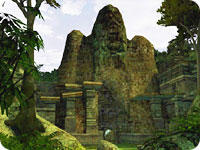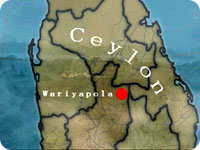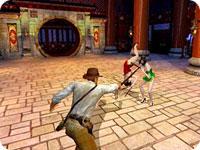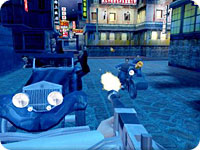
|

The Indiana Jones Phenomenon
|
While not as popular as another devilishly handsome rogue created by George Lucas and also played by Harrison Ford, Indiana Jones still retains a prominent spot in the Lucas/Spielberg pantheon of great popcorn movie characters, even 22 years after his theatrical debut.
Lucas, inspired by the movie serials of his youth, set down the character’s bold strokes while working on his first Star Wars screenplay in the mid 1970s (the Star Wars films, of course, are also big-budget nods to those serials). He envisioned an archeologist who wore a leather jacket and a fedora, carried a bullwhip, and traveled the globe in search of lost relics. Philip Kaufman was originally interested in directing, but he moved on to make The Right Stuff, so Lucas pitched the idea to Steven Spielberg while the two vacationed in Hawaii in 1977. Spielberg, who had always wanted to make a James Bond film but couldn’t (the series was reserved for British filmmakers), saw Indiana Jones as the next best thing. Screens Large and Small Harrison Ford was cast after Tom Selleck dropped out due to his involvement with the TV show Magnum P.I. Raiders of the Lost Ark premiered on June 12, 1981 and quickly became a smash hit, scooping up 11 Academy Award nominations (it won 5 on the big night). The inevitable sequel, Indiana Jones and the Temple of Doom, was actually a prequel, which meant that the story took place before the first film’s adventures. It opened on May 23, 1984 to mixed reviews from critics. Many parents complained that the violence was too extreme for a PG-rated movie, leading the MPAA to create the PG-13 rating. Most fans regard the series’ finale, Indiana Jones and the Last Crusade, the second-best film in the trilogy, right behind Raiders of the Lost Ark. It was released on May 24, 1989 (May premieres are common with Lucas and Spielberg movies). Starring Sean Connery as Indy’s father, The Last Crusade reveals the origin of our hero’s nickname (which was actually the name of a dog George Lucas had in the early 1970s) and brings back the ever-dependable Nazis as villains, who are in pursuit of the Holy Grail this time. The Last Crusade also showed us a young Indiana Jones during the opening sequence, prompting Lucas to create and executive produce a Young Indiana Jones Chronicles TV series that aired from 1992 to 1993. It covered Indy’s adventures between childhood and his early 20s and it featured a wide variety of historical figures, part of Lucas’s desire to have an educational component in the show. Lucas also used the show as a testing ground for computer-generated techniques (such as shooting a small group of soldiers and using a computer to replicate them until they turned into an army) that were refined in his Star Wars Special Editions and prequels. Multimedia Jones Marvel Comics picked up the license to publish Indiana Jones comic books and did so from 1983 to 1986 before canceling the series. Dark Horse Comics, which did the same thing with Star Wars when Marvel dropped it, picked up the lapsed license in the mid-1990s and published new Indiana Jones storylines. The character has also shown up in a series of novels. Indiana Jones was a natural video game hero too, of course, and he made his digitized debut in the Raiders of the Lost Ark cartridge published for the Atari 2600 in 1982. A series of console, computer and even pinball games followed over the years as LucasArts kept the character alive, either by developing the games themselves or licensing the character (the Raiders cartridge was published by Atari as part of a licensing deal). Whither Indy? Everyone’s favorite adventurous archeologist will live forever through games, comic books and novels, but Harrison Ford has expressed his desire to play the character one more time. Lucas and Spielberg would like to make a fourth film too, so it shouldn’t come as a surprise that another Indiana Jones film, known only as “Indy 4” at the moment, is set to go into production in 2004 for a 2005 release. The principals involved with the project will only reveal that the story will be set during the 1950s. If you want to learn more about Indiana Jones, visit TheRaider.net or The Indy Experience.com, as these sites feature copious amounts of information about the making of the original films, influences on the series, links to various articles, and much more. |
 Exotic Locales. Journey deep into the jungle to uncover lost artifacts.  You Are Here. The game evokes the movies with maps that show Indy's journey around the world.  Crack That Whip. Indy can also employ his whip to disarm opponents or pull them toward him.  Trapped. Another of Indy’s sidekicks finds herself in need of a rescue.  Tail Gunner. Take out the bad guys on motorcycles or you won’t get far. |
Tips and Tricks
|
|
Stumped? Visit the walk-throughs available at GameFAQs.com. (The Mac and PC versions of Emperor’s Tomb are the same as the console editions, so you can follow walk-throughs written for any platform.) |
System Requirements
|